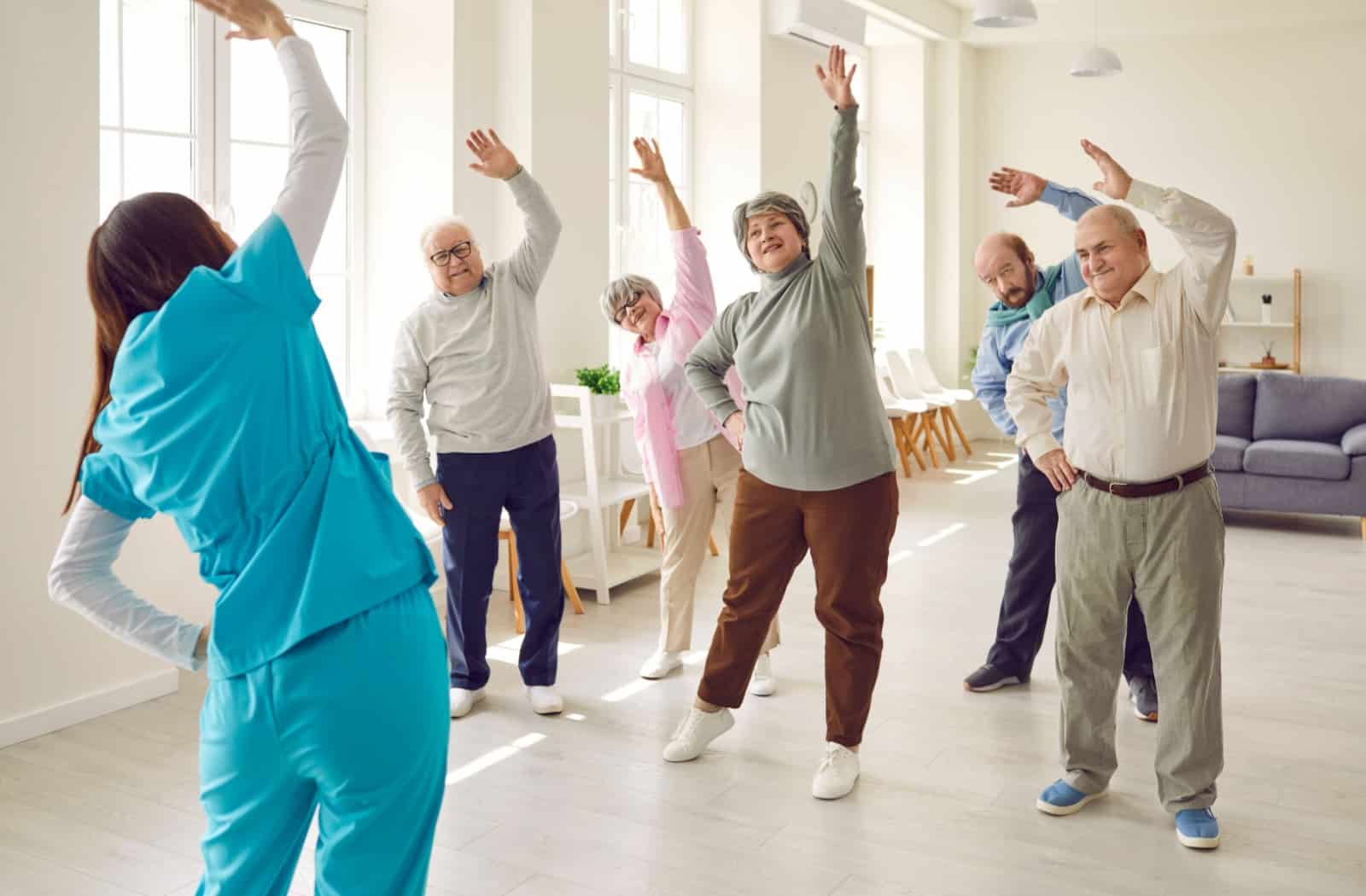Routine physical activity isn’t just beneficial for older adults; in fact, it’s necessary for everyone. Exercise helps improve mental, physical, and emotional well-being, reducing the risk of developing chronic illness, falls, and injuries while promoting better sleep and mood.
As a general rule, adults 65 and older are encouraged to engage in at least:
- 150 minutes of moderate-intensity aerobic activity or 75 minutes of vigorous-intensity aerobic activity per week.
- Strength training at least twice a week.
- Activities that promote balance, flexibility, and mobility at least once a week.
Importance of Physical Activity
Routine physical activity is a cornerstone of holistic health, offering benefits that improve our physical, emotional, and mental well-being.
For older adults, these benefits are even more pronounced, as staying active can significantly enhance quality of life. Improving physical strength, balance, and mobility helps maintain independence.
Exercise doesn’t have to be vigorous to be effective. In fact, activities that align with your health status and mobility level are preferable to those that push you too far.
Gentle exercises can be incredibly beneficial and come with a reduced risk of injury. The key is consistency. Make sure that all of your movements are safe and enjoyable to prevent overexertion, which can lead to a reluctance to continue exercising.
Physically speaking, routine exercise helps maintain a healthy weight, strengthens muscles, enhances heart function, and increases bone density, all which are necessary for promoting healthy aging. Biometric data shows the following benefits of physical activity:
- Cardiovascular health: Consistent exercise helps improve heart health by increasing blood oxygen levels, improving circulation, and reducing the risk of cardiovascular disease.
- Hormone balance: Exercise reduces cortisol levels (cortisol is a stress hormone) and helps regulate insulin levels, improving overall metabolic health.
- Muscle strength and bone density: Strength training and weight-bearing exercises can help build muscle mass and increase bone density, reducing the risk of osteoporosis and fractures.
Emotionally, the release of endorphins during physical activity naturally uplifts mood, reducing symptoms of depression and anxiety, fostering a greater sense of relaxation, and boosting self-esteem.
Participating in group exercises, fitness classes, or community sports creates opportunities for social interaction, reducing feelings of isolation.
Mentally speaking, routine exercise provides an outlet for stress, allowing individuals to better manage the demands of everyday life with a clear and focused mind. Mental benefits of physical activity include:
- Cognitive function: Physical activity has been shown to improve cognitive function, enhance memory, and slow down the progression of dementia.
- Mood enhancement: Exercise releases endorphins, which help in reducing feelings of depression, stress, and anxiety.
- Sleep quality: Regular exercise can help improve the quality of sleep, which is essential for overall well-being.
By consistently incorporating physical activity into one’s lifestyle, individuals can experience an improved quality of life and overall well-being across all facets of health.

Physical Activity for Older Adults
Generally, individuals 65 and older, are encouraged to engage in at least:
- 150 minutes of moderate-intensity aerobic activity or 75 minutes of vigorous-intensity aerobic activity per week.
- Strength training activity at least twice a week.
- Activities that promote balance, flexibility, and mobility at least once a week.
Incorporating aerobic activity with strength training and flexibility provides a well-rounded approach to fitness, allowing you to engage and stimulate various muscle groups and prevent boredom.
Listening to your body is crucial. Pay attention to how you feel during and after exercise.
A challenge is fine, but pain or discomfort isn’t. Don’t be afraid to adjust the intensity or type of activity and allow your body time to rest and heal.
Aerobic Physical Activity
Aerobic exercises are important for maintaining and improving cardiovascular health. Aerobic exercises usually consist of repetitive motions (think walking, swimming, or etc.). They increase your heart rate and blood circulation, helping you move and burn more energy.
A minimum of 150 minutes of moderate physical activity a week is recommended, and can be broken up in several ways:
- 30 minutes a day, 5 times a week.
- 50 minutes a day, 4 times a week.
- And so on.
Moderate physical activity refers to activity that increases your heart rate and breathing. It can be challenging, but shouldn’t be exhausting. Consider, for instance:
- A simple brisk walk
- Biking (also a great option because it doesn’t put too much strain on the joints)
- Doubles tennis (combines exercise with social interaction)
- Gardening
- Swimming (low-impact, fun, and great for joint health)
Some individuals prefer to engage in more challenging levels of activity. In that case, it’s recommended that older adults engage in at least 75 minutes of vigorous physical activity weekly.
A good indicator of vigorous physical activity is the “talk test.” During high-intensity levels, speaking becomes harder, and you may only say a few words before needing to take a breath.
Running, jogging, and uphill cycling are all great examples of vigorous physical activity.
Strength Training
Strength training involves exercises or physical activities designed to improve muscle strength. This usually includes lifting weights, using resistance bands, or performing body-weight exercises like squats and push-ups.
Strength training helps improve muscle mass and strength, bone density, and cardiovascular health, and prevents injury by strengthening muscles, joints, and ligaments. The goal is to progressively increase the resistance or weight over time.
Some fun examples of strength training include:
- Weightlifting, which is a traditional and effective way to build muscle strength.
- Pilates, which uses resistance to improve core strength and flexibility.
- Barre, which incorporates low-weight and resistance for a full-body workout.
Balance Activities
Incorporating balance activities into your physical routine helps improve mobility, flexibility, and balance, and contributes to reducing the risk of falls and injuries. Activities can include:
- Yoga: A full-body workout with varying intensity levels that enhances flexibility, balance, mobility, and mental clarity.
- Tai chi: A gentle form of martial arts that improves balance and reduces stress.
Connect with Community
Routine physical activity is key for maintaining and improving physical, emotional, and mental well-being. The key is staying consistent and connecting with a community can help.
Our community at Dogwood Forest of Grayson offers residents the opportunity to engage in routine physical activity through our fitness classes and wellness programs. To learn more, connect with our team to explore our communities.
